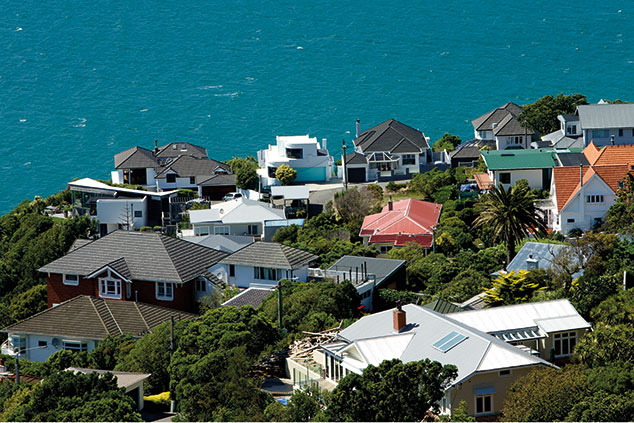
Can I buy a house in New Zealand?
Not unless you are a citizen or a resident. New Zealand’s left-leaning government has banned the sale of existing houses to foreigners, with the exception of Australians and Singaporeans. One government minister said that foreign speculation had turned the local population into “tenants in our land”. Soaring house prices have resulted in the home ownership rate falling to its lowest level since 1951 – 63% of New Zealanders own their own house compared with a record high of 74% in 1991. In all, 3.3% of houses sold in the last quarter – and a fifth of those sold in the centre of New Zealand’s capital Auckland – went to foreign buyers.
Is this part of a trend?
New Zealand’s outright ban is on the draconian end of the spectrum, but many countries are either considering, or have already imposed, restrictions on overseas property buyers. Hong Kong and Singapore both levy extra stamp duty on foreign property investors, while Malaysia’s new government has hinted at introducing some kind of ban. Sydney and Vancouver both imposed extra taxes on foreign buyers in 2016. Vancouver’s initial 15% surcharge was raised to 20% in February this year, while authorities in Toronto impose a similar 15% tax in 2017.
Why the demand for global property?
The IMF has highlighted the issue of “synchronicity” of global house prices – ie, that house prices are tending to move in tandem across countries and major cities around the world. In its Global Financial Stability Report from April 2018, the IMF noted that “synchronicity in housing markets has markedly increased over time”. One theory to explain why is that prime property in the likes of Hong Kong, San Francisco, Vancouver, Sydney, Paris and London has effectively become a separate asset class, driven by global rather than national economic forces. Quantitative easing (money printing) and low-interest-rate policies imposed by major central banks have driven up the prices of assets that pay a yield, such as property. Another factor is a global “flight to safety”, whereby the wealthy, particularly in emerging markets, seek bolt holes in the developed world with relatively stable legal and political systems. For example, Chinese households spent an estimated $40bn on residential property overseas in 2017, report Yuan Yang and Emily Feng in the Financial Times. The effect, in the words of Boris Johnson, has been to turn flats in sought-after cities into “blocks of bullion in the sky”.
What about the UK?
In some ways the UK has been ahead of the trend. In 2012, the then-chancellor, George Osborne, introduced the “Annual Tax on Enveloped Dwellings”, whereby houses of a certain value, purchased using a company (a common tactic of overseas buyers), incurred an annual charge. The threshold has since dropped to £500,000, at which point the annual fee kicks in at £3,600, rising to more than £250,000 for properties worth more than £20m. From 2014, the stamp-duty system was revised to target top-end properties – buyers now pay a 10% tax on the portion of any house price above £925,001, and 12% on the portion above £1.5m. As a result, the stamp-duty bill on a £5m property rose from £350,000 pre-2014 to more than £510,000. And in April 2016, the Treasury imposed a 3% stamp-duty surcharge on purchases of second homes (pushing the top rate of stamp duty up to 15%).
Are high prices really due to foreigners?
The sharp rise in buying costs for prime properties has certainly had an impact on prices in the UK. According to estate agent Savills, house prices in prime central London peaked in 2014, and have since fallen by almost 20% on average. Estate agent Countrywide notes that in 2017 the proportion of rental property in the UK owned by foreign owners had fallen to 5%, from 12% in 2010. However, as Guy Shrubsole notes in The Guardian, much of the land and property owned by offshore companies “in fact belongs to British aristocrats”, meaning that London’s prime market is “driven just as much by homegrown British capital as it is by overseas investors”.
Also, the impact on the wider market – as opposed to the prices of houses that most people could never afford in any case – is questionable. Chris Hamnett of King’s College London has advanced the “fountain theory” of the property market: the foreign money pumping into posh parts of London displaces existing and would-be residents, who then “overflow” into second-tier boroughs, displacing others into areas even further afield. In theory, such “sequential displacements” could eventually ripple out through the whole country. However, any slowdown in UK price growth has not just been about driving up the price for rich foreign buyers – the government’s progressive reduction in the tax advantages once enjoyed by buy-to-let landlords has also sharply reduced the number of investment purchases by would-be landlords.
What about other countries?
Even as governments increasingly adopt the same solutions – penalties for foreigners and incentive schemes for first-time buyers – prices in many prime markets are stalling or falling. House prices in Sydney, for example, are down 5.6% year on year. Prices in Manhattan are flat.
What’s changed? Just as low and falling interest rates drove prices of all assets – not just houses – to extreme levels, so the recent shift to even mildly tighter policy is starting to reverse that effect. Wealthy foreigners do make for convenient political targets at a time of deep discontent among voters. But the reality is that the future of the prime markets that appeal to global tycoons, and house prices for domestic buyers, is mostly dependent on the direction of global interest rates. On that front, for now, the only way is up.